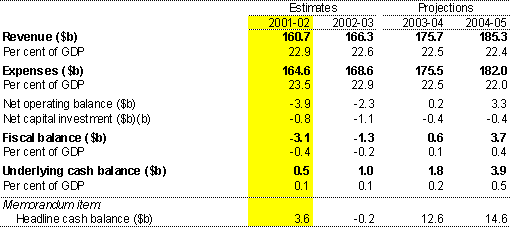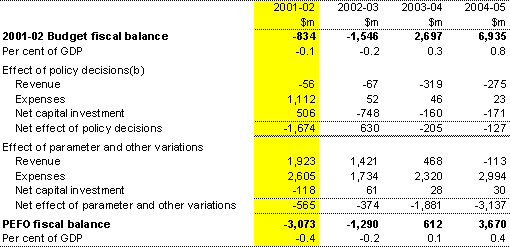Overview
The Australian economy is expected to continue to record solid economic growth and low inflation in 2001-02, despite a much weaker and more uncertain global economic environment.
As outlined in the Mid-Year Economic and Fiscal Outlook 2001-02 (MYEFO), the underlying cash balance is expected to be in surplus in 2001-02 and the forward years. In accrual terms, the fiscal balance is expected to be in deficit in 2001-02 and 2002-03, before returning to surplus in 2003-04.
Table 1 provides revised estimates and projections of the underlying cash and fiscal balances for the period from 2001-02 to 2004-05. These are unchanged from those published in the 2001-02 MYEFO.
Table 1: Summary of budget aggregates

Economic outlook
The Australian economy is expected to grow by around 3 per cent in 2001-02 in year-average terms, down slightly from the 3¼ per cent growth forecast at Budget. In through-the-year terms to the June quarter 2002, growth has been revised down from 4 per cent at Budget to 3¼ per cent. These forecasts are a little below Australia's long-term average growth rate, with the downward revisions mainly reflecting the expected impact of a much weaker global economic environment.
The outlook for world economic growth has deteriorated sharply since the Budget. Some of the downside risks identified at Budget had already come into play prior to the terrorist attacks in the United States on 11 September, with the first major downturn since the early 1990s already underway. The terrorist attacks created additional uncertainty and increased the likelihood of a deeper and more prolonged period of global weakness.
The world economy is now expected to grow by around 2¼ per cent in 2001, down significantly from 3¼ per cent expected at Budget, and down sharply from the 4.7 per cent growth recorded in 2000. This would be the lowest global growth rate since the early 1990s. World economic growth is expected to recover during 2002, to be 2½ per cent, rising to 3½ per cent in 2003. Growth in Australia's major trading partners is expected to be weaker still, at ¾ of a per cent in 2001 and 1½ per cent in 2002, the weakest pace of growth in any two-year period in the last three decades.
While the international outlook is now much weaker, some components of domestic demand are expected to grow more quickly than forecast at Budget, which should ameliorate the impact on overall economic growth to some extent. In particular, dwelling investment is likely to grow very strongly, while public demand is also now likely to be stronger than at Budget.
The more pronounced weakness and uncertainty surrounding the global economic outlook, combined with some recent business collapses in Australia, has led to domestic business and consumer confidence declining from recent above-average levels. In turn, this may result in businesses delaying investment plans in plant and equipment, stock rebuilding, and the employment of new staff.
Lower employment growth, the impact of the recent decline in share prices on household wealth, and lower levels of consumer confidence are all expected to have a dampening influence on household consumer spending in 2001-02. Recent declines in official interest rates and lower oil prices are, however, likely to provide a partial offset.
Domestic demand is now forecast to grow by 3¾ per cent in 2001-02, with net exports expected to detract around ¾ of a percentage point from overall economic growth. At Budget, domestic demand was forecast to grow by 3 per cent, with net exports forecast to contribute a further ¼ of a percentage point to growth.
In light of these developments, employment growth is now forecast to be ¾ of a per cent in 2001-02 in year-average terms, compared with 1 per cent growth expected at Budget. The unemployment rate is forecast to be around 7 per cent in the June quarter 2002, unchanged from Budget, reflecting a more muted rise in labour force participation.
The headline Consumer Price Index (CPI) is forecast to increase by around 2¾ per cent in 2001-02 in year-average terms, compared with a 2 per cent increase forecast at Budget. The upward revision to the CPI mainly reflects the expected impact of a number of one-off factors, rather than representing any significant increase in ongoing inflationary pressures. In particular, higher insurance premiums, electricity prices, meat prices and domestic airfares are expected to put upward pressure on the CPI relative to earlier expectations. The recent modest decline in the exchange rate, if sustained, could also increase the CPI slightly over coming quarters. On the other hand, weak world growth and ongoing unused domestic capacity should help to contain inflationary pressures.
Reflecting the impact of weak growth in Australia's export markets, the current account deficit is forecast to increase to around 3¾ per cent of GDP in 2001-02, somewhat higher than the 3 per cent forecast at Budget, but significantly below the long-term average.
With a forecast gradual recovery in world economic growth as 2002 proceeds, and with world growth expected to return to around trend rates of growth in 2003, a strengthening in activity is likely in Australia in 2002-03. GDP growth in Australia is expected to increase to 3½ per cent in 2002-03 in year-average terms and a strong 4¼ per cent in through-the-year terms, facilitated by accommodative monetary and fiscal policies. Employment growth is expected to increase to 1¼ per cent, while inflation is expected to remain comfortably within the Reserve Bank's target zone at around 2½ per cent. Business investment and household consumer spending are both expected to grow solidly in 2002-03.
Table 2 presents the major economic parameters which underpin the Pre-Election Economic and Fiscal Outlook 2001 (PEFO) financial estimates. The parameters for 2001-02 and 2002-03 are Treasury forecasts, while the parameters for 2003-04 and 2004-05 are projections based on long-term average growth rates, consistent with the usual conventions used in the Budget.
Table 2: Major economic parameters (percentage change
from previous year)

(a) Labour Force Survey basis.
(b) Average earnings (national accounts basis).
There continue to be major uncertainties surrounding the economic outlook.
- Ongoing uncertainty could see the current US cyclical downturn gather momentum. This would have adverse effects on other countries, particularly Australia's major trading partners in the Asia region. The downturn would be exacerbated by a further escalation of international tensions, disorderly adjustment in financial markets or by higher oil prices. In the short-term, the balance of risks is probably on the downside. Any of these factors would act as a further brake on Australian growth.
- On the other hand, if the current uncertainty dissipates quickly, growth in the US and elsewhere could rebound sooner, and at a faster pace, supported by the fiscal and monetary policy stimulus now in train and a restoration of business and consumer confidence. Under these circumstances, and given the competitive exchange rate, Australia's exports would be stronger than forecast and, with very low interest rates and a recovery in confide
nce, consumption and investment in Australia could rebound rapidly. The result would be substantially stronger domestic economic growth on average across 2001-02 and 2002-03 than currently forecast.
Fiscal outlook
An underlying cash surplus of $0.5 billion, or 0.1 per cent of GDP, is forecast in 2001-02. The fiscal outlook is for further underlying cash surpluses in the forward years.
In accrual terms, a fiscal deficit of $3.1 billion is forecast for 2001-02, or -0.4 per cent of GDP. A fiscal balance deficit is also expected in 2002-03, with surpluses projected for 2003-04 and 2004-05.
Table 3 provides a summary of the major budget aggregates.
Table 3: Commonwealth general government budget aggregates(a)

(a) All estimates are based on Government Finance Statistics (GFS) standards, but with goods and services tax (GST) revenue collected on behalf of the States and Territories netted off revenue and expenses.
(b) Net capital investment is defined as net acquisition of non-financial assets.
Table 4 provides a reconciliation between the fiscal balance estimates published in the 2001-02 Budget and the 2001 PEFO.
Table 4: Reconciliation of 2001-02 Budget and 2001 PEFO fiscal balance estimates(a)

(a) A positive number for revenue indicates an increase in the fiscal balance, while a positive number for expenses and net capital investment indicates a decrease in the fiscal balance.
(b) Excludes the public debt net interest effect of policy measures.
Relative to the 2001-02 Budget, total Commonwealth general government revenue has been revised up in 2001-02 by $1.9 billion. The major influences on the revenue outlook are the flow-on effects of a stronger revenue base in 2000-01 and continued strength in collections to end-September 2001, partly offset from 2002-03 by the effects of weaker forecast nominal GDP growth. As a consequence of these influences, total revenue has been revised up in all years other than in 2004-05.
Estimated expenses in 2001-02 have increased by $3.7 billion since Budget. This increase reflects the combined effect of economic parameter variations, including the impact of higher than previously anticipated prices and wages growth in 2001-02, new policy measures, and a range of programme specific parameter and other variations. Estimated expenses have also been revised upwards since the 2001-02 Budget in 2002-03 and the following two years.
Forecast net capital investment in 2001-02 has increased by $0.4 billion since the 2001-02 Budget. This increase largely reflects the rescheduling of some Defence property sales from 2001-02 to 2002-03 (proceeds from the sale of non-financial assets, including property, reduce net capital investment and boost the fiscal balance). Higher anticipated property sales in 2002-03 and the following two years have resulted in downward revisions to projected net capital investment in those years since Budget.
Further information on changes in the fiscal estimates since the 2001-02 Budget is provided in the Mid-Year Economic and Fiscal Outlook 2001-02 (MYEFO).
Appendix A provides summary financial statements on both a Government Finance Statistics (GFS) basis and an Australian Accounting Standards (AAS31) basis. Appendix B provides a summary of policy measures taken from the 2001-02 Budget to the commencement of the caretaker period on 8 October 2001.